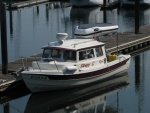There is an entire other source of information which is being disregarded in this discussion. That is aerial maps/satellite maps. I often print these out ahead of time, and put waypoints on them--especially in areas where the charts are poor, or old. Also there are lots of changes along any coastline or waterway
Be sure that you have the right DATUM selected on your chart plotter.
When we were near the headwaters of the St. Johns River, we found that the charts were worthless--both paper and chart plotter. Enter the I pad and Google Earth. We quickly found the way up the tributary. As we went on up, we identified where we were by the various bends, power lines, the rare structure--all of which were quite accurate. There are a number of Topo map, satellite images which are available on line, and in printed format.
I am also "old school" and do much of my planning on the computer or charts. However, the GPS plotters, I pad are far better. Also I can think of many situations where there was poor visibility, due to darkness, fog etc. This is especially difficult when approaching a coastline with no visibility. I sailed to Catalina Isand many times at night, long before any electronic aids were available. I compensated for the small current, and would often arrive early in the AM--to an area, with no lights. One night I thought I knew where I was, and turned right. After going 4 miles (about an hour against the windI) I realized I was at the West End of the Island. Turning around, I found my cove (which I had been to hundreds of times, only a few hundred yards to the East (left) of where I first made land fall. The night the current was just enough different to make the difference.
Often maps are way out of date--and cannot be relied on for accuracy---especially outside of the US. When I have found major discrepancies, I have reported them, with documentation, to NOAA. Yes, many of the charts on the plotters are off--no cartography company is without fault. Over 80 % of maps have my house address in the wrong location--including our Country GIS system.

